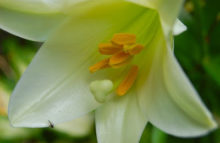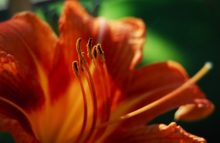As I drove back from a meeting today, this little fountain of sunshine rose up from all the mousy brown blanketing the city. Had to double back with my camera.
This is the witch hazel, Hamamelis, so valuable for its splash of colour (and, in many cases, perfume!) at one of the most drab and dreary times of year. There are species of witch hazel native to North America, but I suspect this is one of the showier Asian hybrids.
 Judging by my handy-dandy Reader’s Digest A-Z Encyclopedia of Garden Plants (looks like the same book is now published by DK; view it here), it might be H. x intermedia ‘Arnold Promise.’ That “x” in a name indicates it’s a hybrid cross, in this case between H. japonica and H. mollis, the latter of which is Chinese witch hazel. All are hardy in Zones 5-9; some would bloom in February – a sign of how hard a winter 2008-9 has been.
Judging by my handy-dandy Reader’s Digest A-Z Encyclopedia of Garden Plants (looks like the same book is now published by DK; view it here), it might be H. x intermedia ‘Arnold Promise.’ That “x” in a name indicates it’s a hybrid cross, in this case between H. japonica and H. mollis, the latter of which is Chinese witch hazel. All are hardy in Zones 5-9; some would bloom in February – a sign of how hard a winter 2008-9 has been.
 For those who insist on native forms, there seem to be two, the spring-blooming H. vernalis, which has a less compact, treelike habit than the Asians, and the fall-blooming H. virginiana.
For those who insist on native forms, there seem to be two, the spring-blooming H. vernalis, which has a less compact, treelike habit than the Asians, and the fall-blooming H. virginiana.
I tend to be a relativist when it comes to garden choices. If we only depended on what was native to our area, then Europeans should not be growing tomatoes or potatoes. My belief is that our plant choices should be guided by growing conditions, and what can be achieved with gentle intervention: mimicking nature as much as possible.
An Asian species of a North American native works in my philosophy. Especially when it looks so glorious in such a tired month. Would love to make room in my garden for one. If I can only reconcile the “moist” as well as the “well drained.”
One particularly appealing cultivar is H. x intermedia ‘Jelena’ (can we pronounce the J as H?), with its promise of orange and red flowers in late winter and coppery red fall foliage. Found a charming review of it (albeit not from a Toronto gardener) here. Think I’ll add it to my Lust List.




